Optimization Simulation of Land Use in Jiangsu Province Under Multiple Scenarios Based on the PLUS-InVEST Model
Abstract
1. Introduction
2. Materials and Methods
2.1. Study Area
2.2. Data
2.3. Method
2.3.1. InVEST Model
2.3.2. Carbon Density Adjustment
2.3.3. Multi-Scenario Land Use Simulation and Prediction
- (1)
- Natural Development Scenario (ND)
- (2)
- Economic Development Scenario (ED)
- (3)
- Ecological Protection Scenario (EP)
- (4)
- High Carbon Storage Development Scenario (HCD)
- (5)
- Sustainable Development Scenario (SD)
2.3.4. Geodetector to Analyze the Driving Variables
3. Results
3.1. Spatiotemporal Evolution Patterns of Land Use from 1995 to 2020
3.2. Spatiotemporal Changes in Carbon Stocks in Jiangsu from 1995 to 2020
3.3. Spatial Autocorrelation Analysis
3.4. Land Use and Cover Changes in 2030 Under Different Development Scenarios
3.5. Benefits Under Different Development Scenarios in 2030
3.6. Land Use and Low-Carbon Optimization
4. Discussion
5. Conclusions
Author Contributions
Funding
Institutional Review Board Statement
Informed Consent Statement
Data Availability Statement
Acknowledgments
Conflicts of Interest
References
- Rafique, K.; Abbas, S.; Abbas, H.; Ullah, K. Assaying ramifications of climate change over productivity growth in developing countries. Gondwana Res. 2024, 130, 278–290. [Google Scholar] [CrossRef]
- Xi, J. Statement by H.E. Xi Jinping President of the People’s Republic of China at the General Debate of the 75th Session of the United Nations General Assembly. 2020. Available online: https://www.mfa.gov.cn/eng/xw/zyjh/202405/t20240530_11341451.html (accessed on 1 March 2025).
- Li, G.; Sun, L.; Ji, S.; Li, X.; Cong, J.; Han, D.; Wang, G.; Gao, C. Low-severity fire promote carbon emissions in permafrost peatlands of the Great Khingan Mountains, Northeast China. Catena 2025, 252, 108870. [Google Scholar] [CrossRef]
- Yang, S.; Wen, L.; Zhang, A. The spatiotemporal response of land-use carbon emissions to climate change. Ecol. Indic. 2025, 170, 112893. [Google Scholar] [CrossRef]
- Xia, B.; Xiao, J. Carbon emission reduction pathways benefitting from concrete component reuse: A macroscopic perspective. J. Clean. Prod. 2024, 478, 143924. [Google Scholar] [CrossRef]
- Chen, Y.; Zhang, C. Characteristics of Spatial–Temporal Evolution of Carbon Emissions from Land Use and Analysis of Influencing Factors in Hubao-Eyu Urban Agglomerations, China. Sustainability 2024, 16, 7565. [Google Scholar] [CrossRef]
- Liu, C.; Hu, S.; Wu, S.; Song, J.; Li, H. County-level land use carbon emissions in China: Spatiotemporal patterns and impact factors. Sustain. Cities Soc. 2024, 105, 105304. [Google Scholar] [CrossRef]
- Zhao, L.; Zhang, C.; Wang, Q.; Yang, C.; Suo, X.; Zhang, Q. Climate extremes and land use carbon emissions: Insight from the perspective of sustainable land use in the eastern coast of China. J. Clean. Prod. 2024, 452, 142219. [Google Scholar] [CrossRef]
- Wei, W.; Li, Y.; Ma, L.; Xie, B.; Hao, R.; Chen, D.; Yang, S. Carbon emission change based on land use in Gansu Province. Environ. Monit. Assess. 2024, 196, 311. [Google Scholar] [CrossRef]
- Bacani, V.M.; da Silva, B.H.M.; Sato, A.A.d.S.A.; Sampaio, B.D.S.; da Cunha, E.R.; Vick, E.P.; de Oliveira, V.F.R.; Decco, H.F. Carbon storage and sequestration in a eucalyptus productive zone in the Brazilian Cerrado, using the Ca-Markov/Random Forest and InVEST models. J. Clean. Prod. 2024, 444, 141291. [Google Scholar] [CrossRef]
- Crawford, A.F.; Maidment, D.W.; Thebaud, N.; Masurel, Q.; Evans, N.J. A revised stratigraphic model for the~ 1910–1835 Ma Tanami Group, the Northern Territory, Australia: Implications for exploration targeting. Precamb. Res. 2024, 411, 107510. [Google Scholar] [CrossRef]
- Prasertsoong, N.; Puttanapong, N. Predicting Urban Land Expansion and Local Economic Growth by Integrating CLUE-S and Economic Model: An Application to Ban Chang District, Thailand. J. Geovisual. Spatial Anal. 2025, 9, 7. [Google Scholar] [CrossRef]
- He, P.; Li, X.; Deng, S.; Tu, Y.; Shen, W. Carbon emissions prediction method of industrial parks based on NSGA-II multi objective genetic algorithm. Int. J. Energy Technol. Policy 2024, 19, 286–301. [Google Scholar] [CrossRef]
- Karthick, B. Modelling a sustainable supply chain with variable production and ambiguous carbon emission factor using a genetic algorithm. Model. Earth Syst. Environ. 2024, 10, 1941–1958. [Google Scholar] [CrossRef]
- Kumar, N.; Bhunia, S.; Dey, P. Data envelopment analysis and multi-objective genetic algorithm based optimization of energy consumption and greenhouse gas emissions in rice-wheat system. Energy 2024, 313, 133680. [Google Scholar] [CrossRef]
- Windarto, C.; Lim, O. The operating parameter optimization of spark duration effect on the performance and emission characteristics of direct-injection propane by genetic algorithm. Energy 2024, 311, 133365. [Google Scholar] [CrossRef]
- Boiger, T.; Mair-Bauernfeind, C.; Asada, R.; Stern, T. Optimizing the utilization of harvested wood products for maximum greenhouse gas emission reduction in a bioeconomy: A multi-objective optimization approach. J. Environ. Manag. 2025, 373, 123424. [Google Scholar] [CrossRef]
- Shi, G.; Wang, Y.; Zhang, J.; Xu, J.; Chen, Y.; Chen, W.; Liu, J. Spatiotemporal Pattern Analysis and Prediction of Carbon Storage Based on Land Use and Cover Change: A Case Study of Jiangsu Coastal Cities in China. Land 2024, 13, 1728. [Google Scholar] [CrossRef]
- Li, Y.; Peng, Y.-L.; Cheng, W.-Y.; Peng, H.-N. Spatial-temporal evolution and multi-scenario prediction of carbon emissions from land use in the adjacent areas of nature reserves. Ecol. Indic. 2025, 170, 113047. [Google Scholar] [CrossRef]
- Qiao, Y.; Zhang, J.; Huo, T.; Du, Q.; Cai, W. Shaping China’s carbon peak roadmaps: A dynamic model for provincial residential buildings. Sustain. Prod. Consum. 2025, 55, 389–406. [Google Scholar] [CrossRef]
- Taweesan, A.; Lalitaporn, P.; Sooktawee, S.; Kanabkaew, T. Mitigating air quality and climate impact: A comprehensive analysis of paddy field burning emissions and green mechanisms for sustainable agriculture. Environ. Sustain. Indic. 2025, 26, 100662. [Google Scholar] [CrossRef]
- Muduli, A.; Chattopadhyay, P.B. Implications of multi-decadal land use changes on groundwater regime in tropical coastal regions. Groundw. Sustain. Dev. 2025, 29, 101419. [Google Scholar] [CrossRef]
- Zhang, X.; Zhou, J.; Li, M. Analysis on spatial and temporal changes of regional habitat quality based on the spatial pattern reconstruction of land use. Acta Geogr. Sin. 2020, 75, 160–178. [Google Scholar]
- Xu, Y.; Liu, Y.; Wei, M.; Lu, J. Land Cover Classification of the Yangtze River Delta Using MODIS Data. Acta Geogr. Sin. 2007, 62, 640–648. [Google Scholar]
- Peng, B.; An, X.; Chen, F.; Pu, L. A Study on Sustainable Land Use in the Yangtze River Delta. J. Nat. Resour. 2001, 16, 305–312. [Google Scholar]
- Qi, L.; Luan, Z.; Wei, M.; Yan, D.; Li, J.; Yao, X.; Liu, Y.; Xie, S.; Sheng, Y. Spatial and temporal variations of ecosystem service values in Jiangsu Province based on land-use change. J. Nanjing For. Univ. 2023, 47, 200–208. [Google Scholar]
- Hou, R.; Xia, C.; Chen, J.; Zhang, Q.; Li, H.; Huang, J.; Huang, X.; Deng, J.; Han, X.; An, T. Carbon storage and carbon sink of forest land and other biomass in the Yangtze River Economic Belt. Acta Ecol. Sin. 2022, 42, 9483–9498. [Google Scholar]
- Li, K.; Cao, J.; Adamowski, J.F.; Biswas, A.; Zhou, J.; Liu, Y.; Zhang, Y.; Liu, C.; Dong, X.; Qin, Y. Assessing the effects of ecological engineering on spatiotemporal dynamics of carbon storage from 2000 to 2016 in the Loess Plateau area using the InVEST model: A case study in Huining County, China. Environ. Dev. 2021, 39, 100641. [Google Scholar] [CrossRef]
- Shi, J.; Shi, P.J.; Wang, Z.Y.; Cheng, F.Y. Spatial-temporal evolution and prediction of carbon storage in Jiuquan City ecosystem based on PLUS-InVEST model. Environ. Sci. 2024, 45, 300–313. [Google Scholar]
- Liu, Z.; Zhou, Q.; Zhou, J.; Ma, Q.; Kuang, W.; Daryanto, S.; Wang, L.; Jing, W.; Bo, L.; Zhu, J.; et al. Scale effect of climate factors on soil organic carbon stock in natural grasslands of northern China. Ecological Indicators. 2023, 146, 109757. [Google Scholar] [CrossRef]
- Wang, D.D.; Shi, X.Z.; Wang, H.J.; Yu, D.S.; Sun, W.X.; Ren, H.Y.; Zhao, Y.C.; Weindorf, D.C. Scale effect of climate on soil organic carbon in the Uplands of Northeast China. J. Soils Sediments 2010, 10, 1007–1017. [Google Scholar] [CrossRef]
- Chen, X.; Li, Y.; Wang, H.; Zhang, Y.; Liu, Z. Multi-Scenario Land Use/Cover Change and Its Impact on Carbon Storage Based on the Coupled GMOP-PLUS-InVEST Model in the Hexi Corridor, China. Sustainability 2024, 16, 1402. [Google Scholar]
- Liu, Y.; Wang, J.; Zhang, Y.; Li, X.; Wang, Y.; Wang, S. The Response of Carbon Storage to Multi-Objective Land Use/Cover Spatial Optimization and Vulnerability Assessment. Sustainability 2024, 16, 2235. [Google Scholar]
- The State Council of the People’s Republic of China. Approval of the National Territorial Spatial Plan for Wuxi City, Jiangsu Province. Available online: https://english.www.gov.cn/policies/latestreleases/202501/16/con_WS6788eb26c6d0868f4e8eedd4.html (accessed on 1 May 2025).
- Wang, J.-F.; Li, X.-H.; Christakos, G.; Liao, Y.-L.; Zhang, T.; Gu, X.; Zheng, X.-Y. Geographical detectors-based health risk assessment and its application in the neural tube defects study of the Heshun Region, China. Int. J. Geogr. Inf. Sci. 2010, 24, 107–127. [Google Scholar] [CrossRef]
- Wang, J.-F.; Zhang, T.-L.; Fu, B.-J. A measure of spatial stratified heterogeneity. Ecol. Indic. 2016, 67, 250–256. [Google Scholar] [CrossRef]
- Luo, S.Q.; Hu, X.M.; Sun, Y.; Yan, C.; Zhang, X. Multi-scenario land use change and its impact on carbon storage based on coupled Plus-Invest model. Chin. J. Eco-Agric. 2023, 31, 300–314. [Google Scholar]
- Jiangsu Provincial People’s Government News Center. Jiangsu Completes Afforestation of 15,560 Hectares in 2023. Jiangsu Provincial People’s Government. 27 April 2024. Available online: https://en.jiangsu.gov.cn/art/2024/4/27/art_54122_11229863.html (accessed on 1 March 2025).
- Zhu, M.; Zhu, D.; Huang, M.; Gong, D.; Li, S.; Xia, Y.; Lin, H.; Altan, O. Assessing the Impact of Climate Change on the Landscape Stability in the Mediterranean World Heritage Site Based on Multi-Sourced Remote Sensing Data: A Case Study of the Causses and Cévennes, France. Remote Sens. 2025, 17, 203. [Google Scholar] [CrossRef]
- Gong, D.; Huang, M.; Ge, Y.; Zhu, D.; Chen, J.; Chen, Y.; Zhang, L.; Hu, B.; Lai, S.; Lin, H. Revolutionizing ecological security pattern with multi-source data and deep learning: An adaptive generation approach. Ecol. Indic. 2025, 173, 113315. [Google Scholar] [CrossRef]
- Zhang, Y.; Li, X.; Wang, Y.; Liu, Y. Unbalanced development characteristics and driving mechanisms of regional urban spatial form: A case study of Jiangsu Province, China. Sustainability 2021, 13, 3121. [Google Scholar] [CrossRef]
- Wu, X.W.; Guo, F.C. Analysis and prediction of carbon storage changes in Jiangsu Province based on the Invest model and Flus model. Chin. J. Eco-Agric. 2024, 32, 230–239. [Google Scholar]
- Deng, Y.L.; Huang, M.; Gong, D.H.; Ge, Y.; Lin, H.; Zhu, D.Y.; Chen, Y.; Altan, O. Carbon balance dynamic evolution and simulation coupling economic development and ecological protection: A case study of Jiangxi Province at county scale from 2000 to 2030. Int. J. Digit. Earth 2025, 18, 2448572. [Google Scholar] [CrossRef]
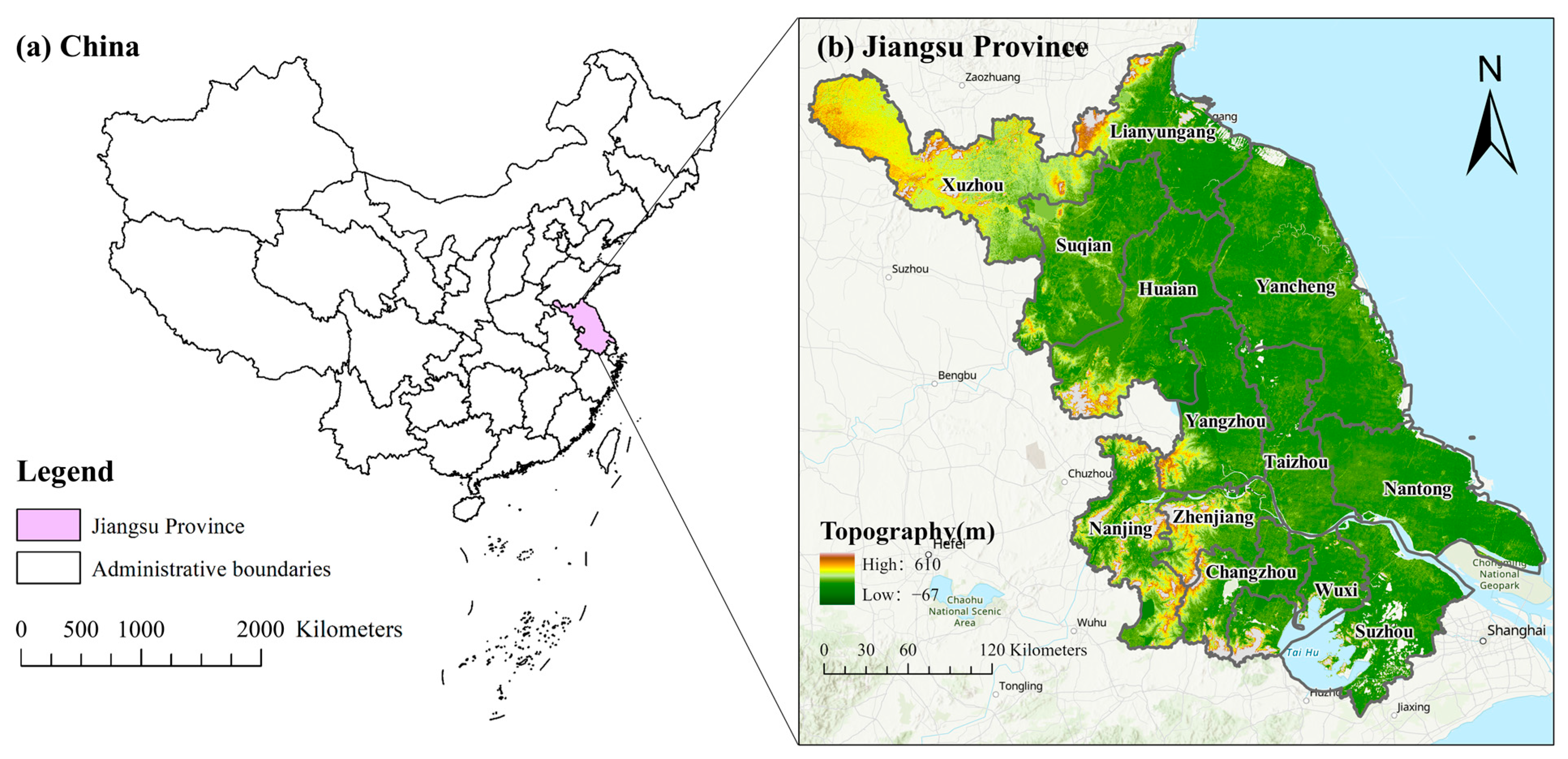
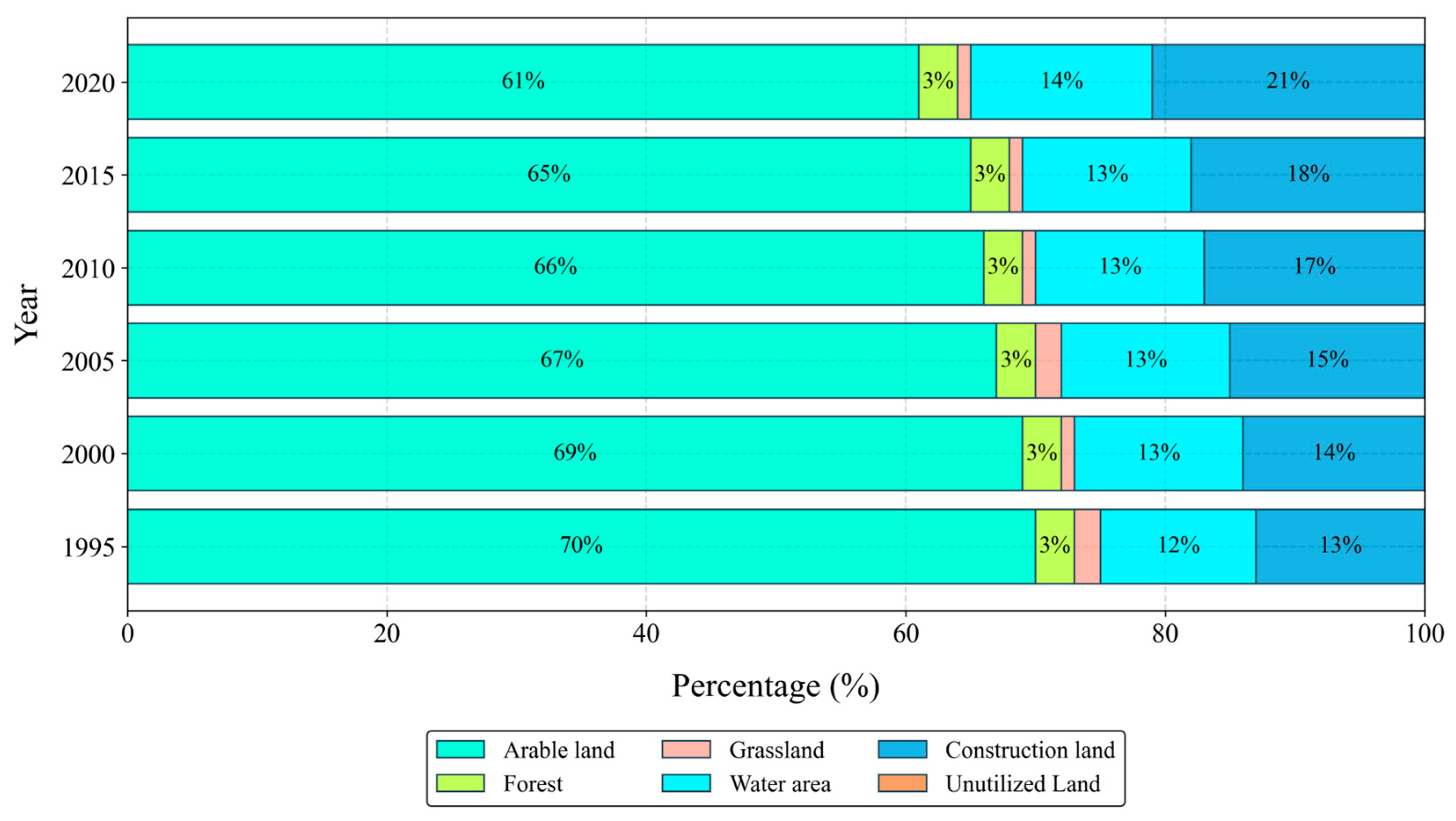
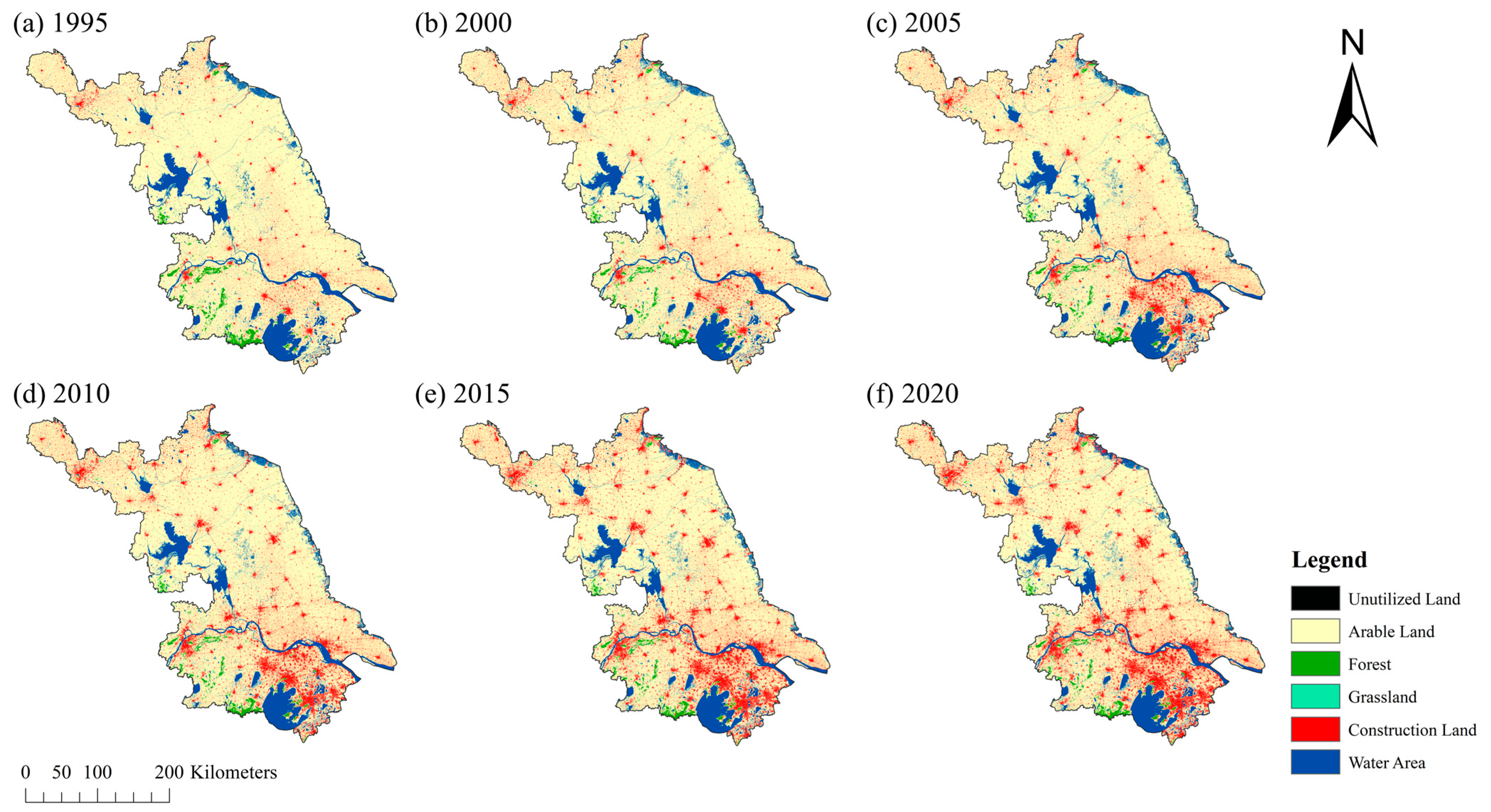
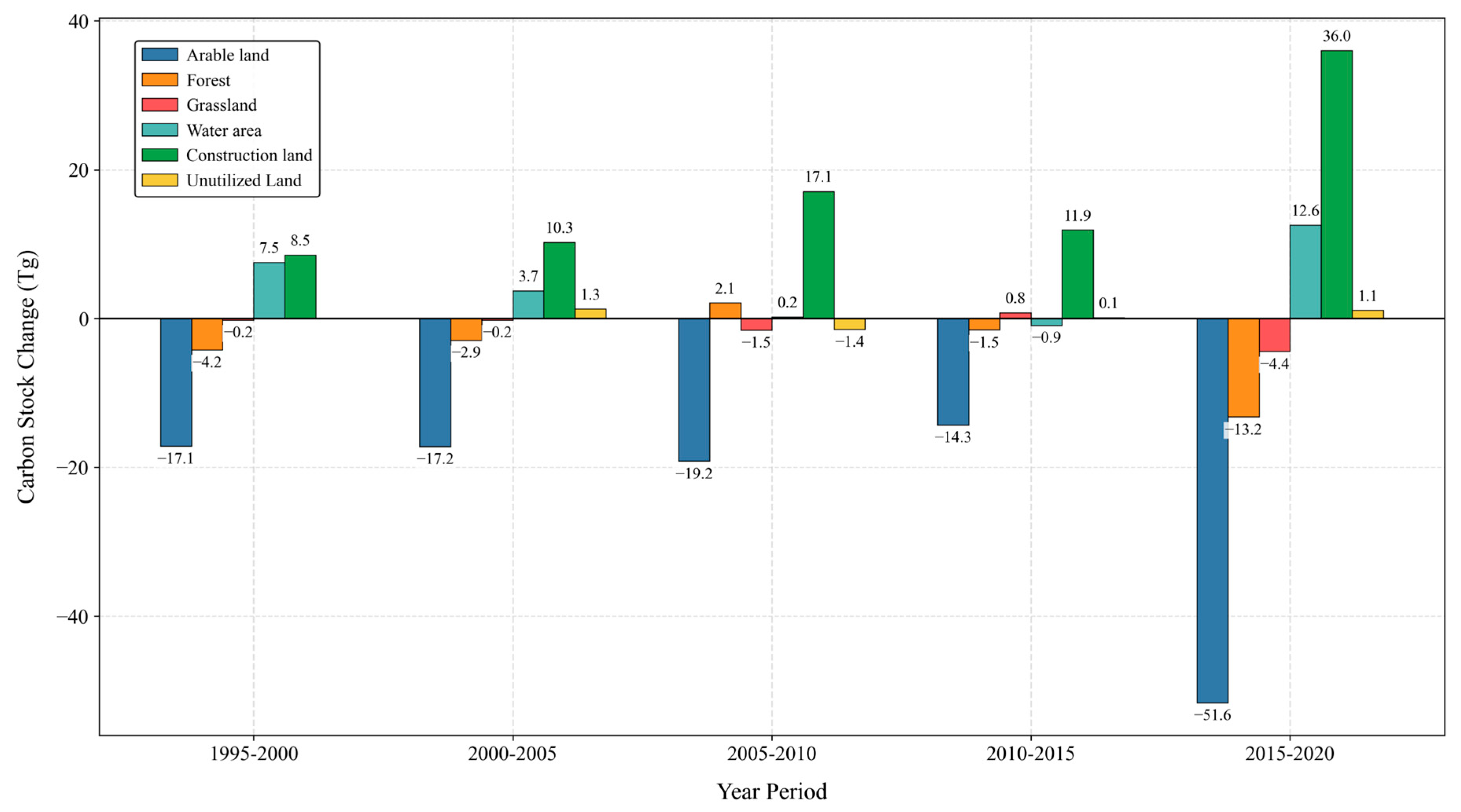
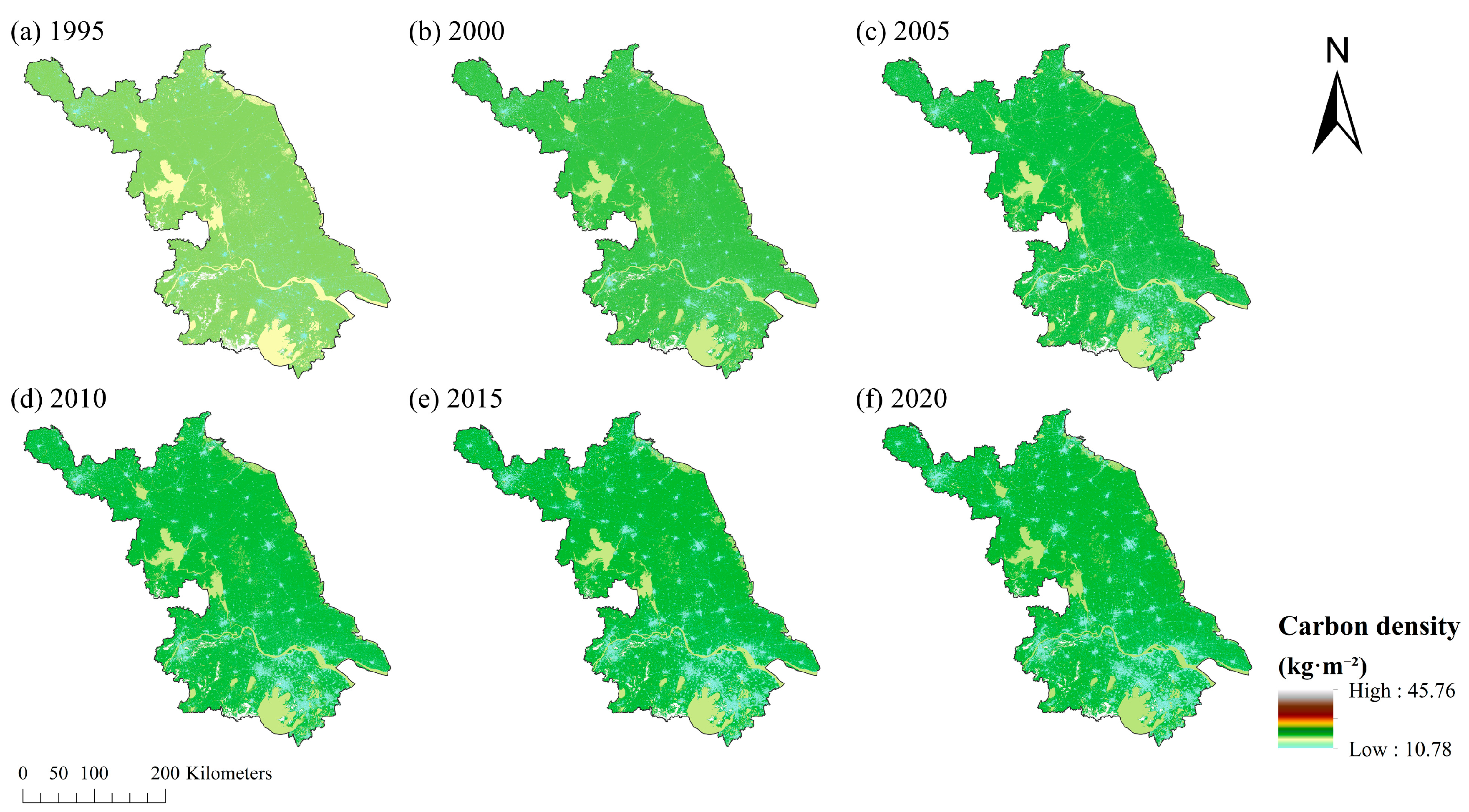
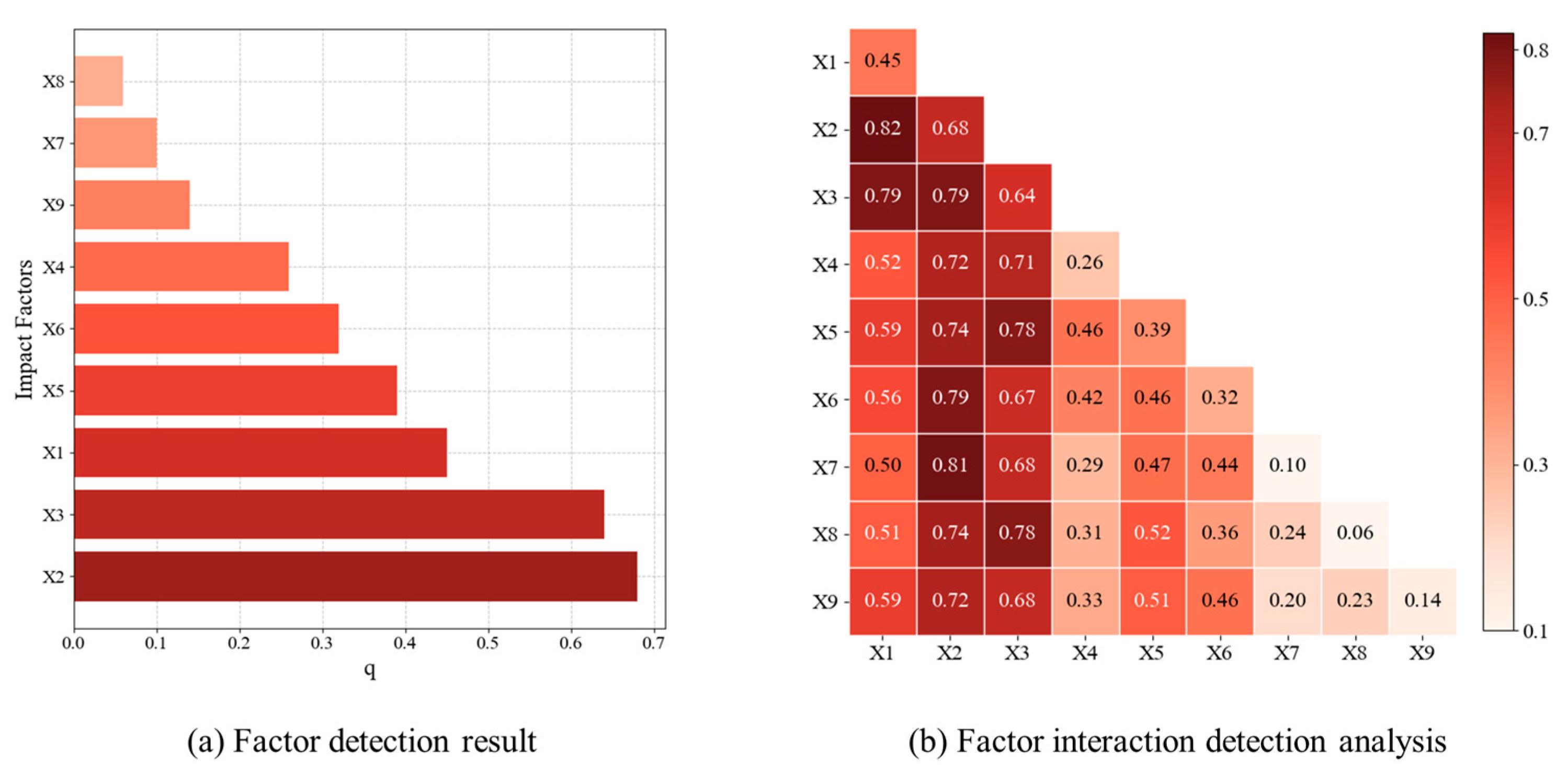

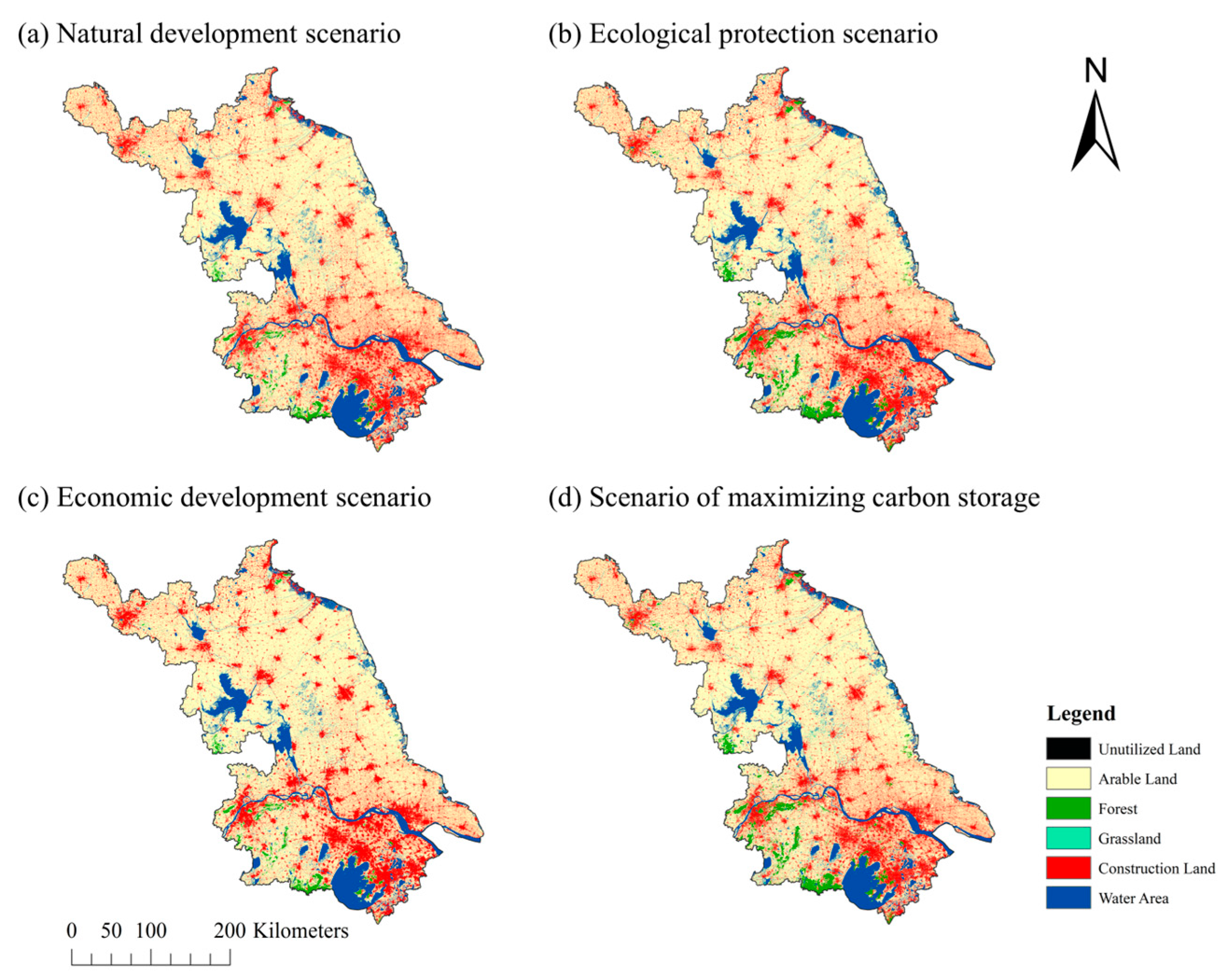

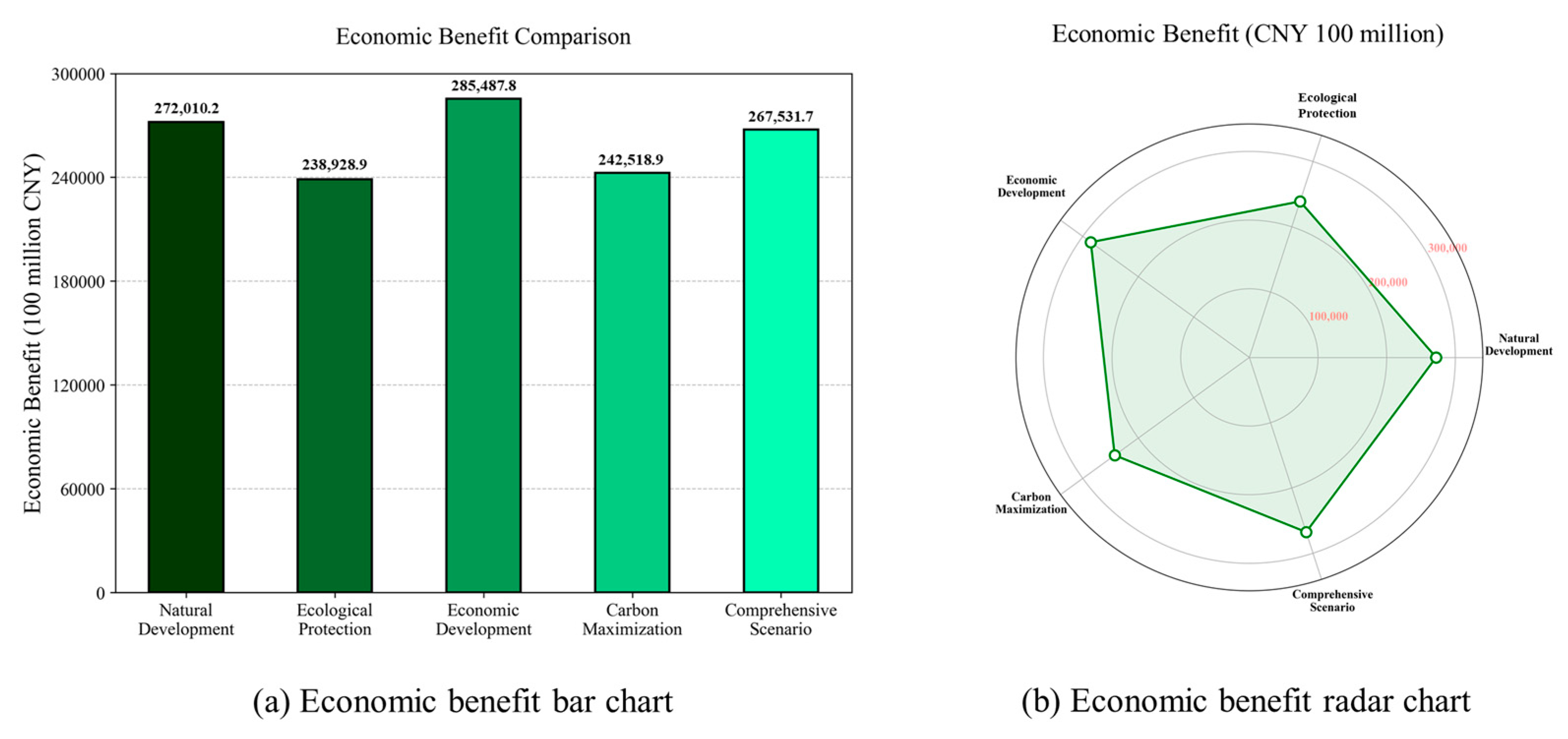
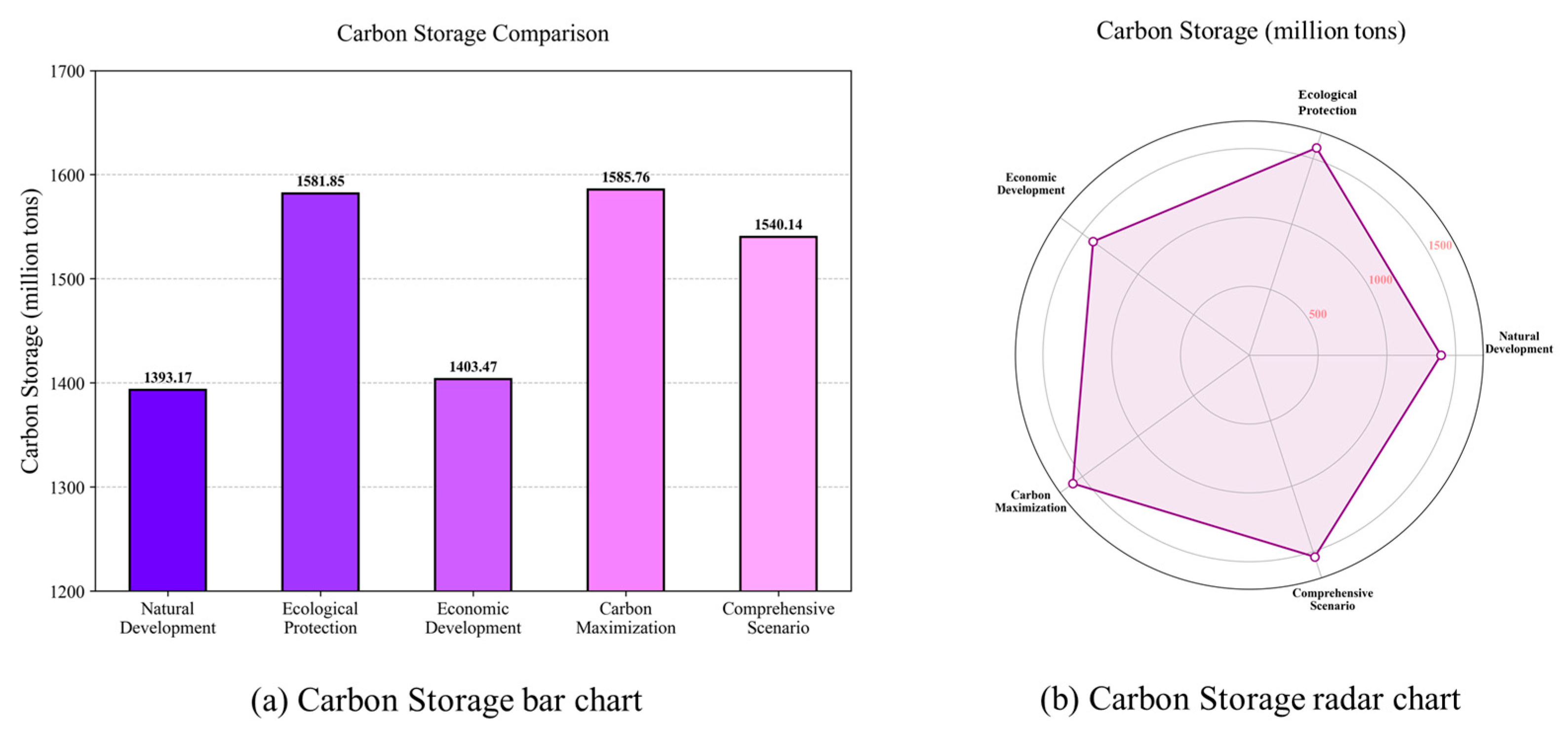
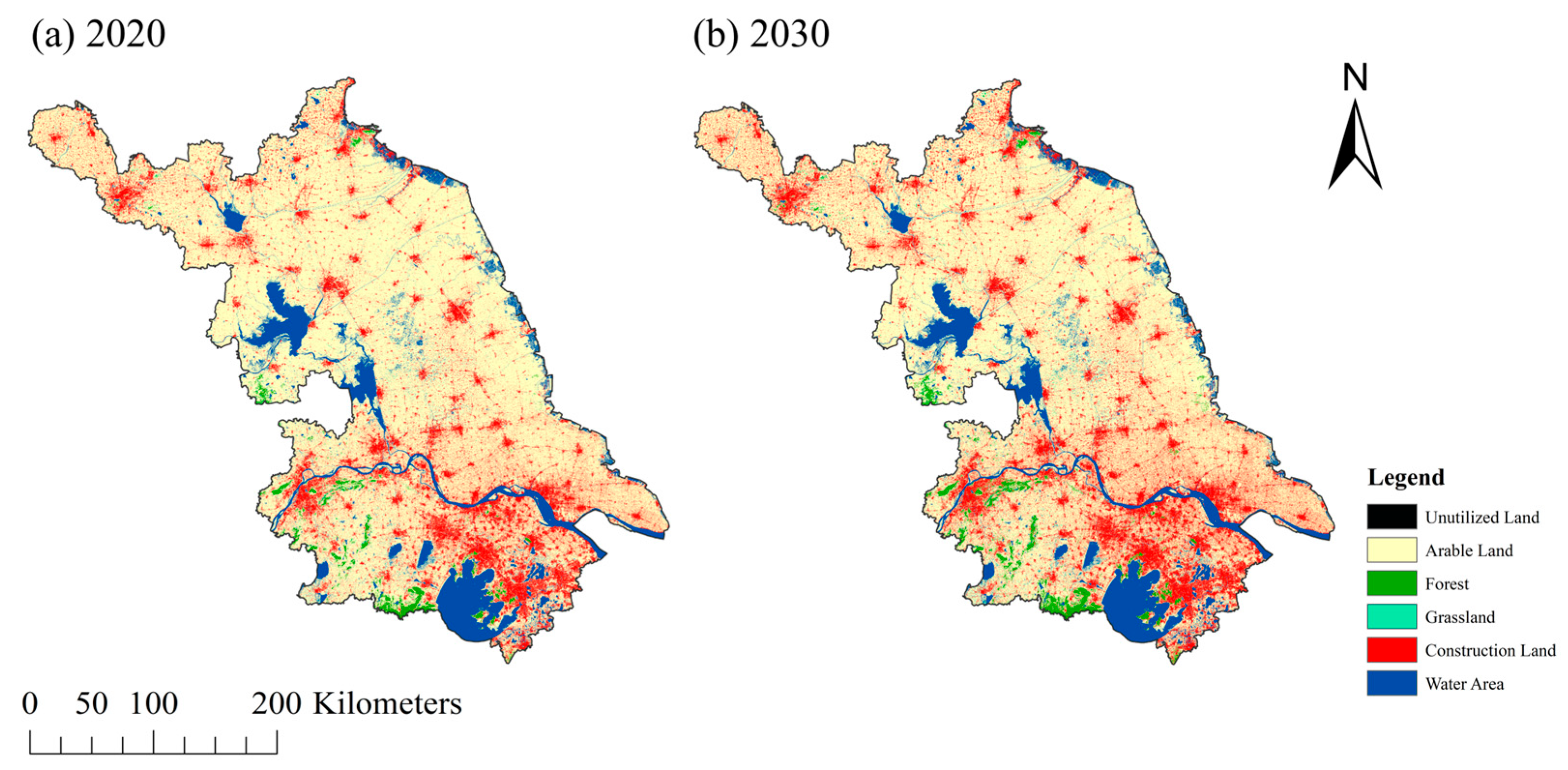
| Organic Carbon Density | Arable Land | Forest Land | Water Area | Grassland | Construction Land | Unused Land |
|---|---|---|---|---|---|---|
| aboveground | 0.54 | 3.98 | 0.23 | 0.81 | 0.18 | 0.11 |
| underground | 0.25 | 0.86 | 0.18 | 0.28 | 0.06 | 0.21 |
| soil | 12.29 | 22.53 | 12.45 | 10.96 | 10.52 | 11.28 |
| dead | 0.38 | 18.39 | 0.01 | 3.17 | 0.02 | 0.01 |
| Judgement Basis | Interaction Types |
|---|---|
| q(x1∩x2) < min [q(x1), q(x2)] | Nonlinear weakening |
| min(q(x1), q(x2)) < q(x1∩x2) < max [q(x1), q(x2)] | Single-factor nonlinear weakening |
| q(x1∩x2) > max [q(x1), q(x2)] | Dual-factor enhancement |
| q(x1∩x2) = q(x1) + q(x2) | Independence |
| q(x1∩x2) > q(x1) + q(x2) | Nonlinear enhancement |
| Year | Cropland | Forest | Grassland | Water | Construction Area | Unused Area | Total |
|---|---|---|---|---|---|---|---|
| 1995 | 71,854 | 3501 | 1102 | 12,482 | 13,671 | 56 | 102,666 |
| 2000 | 70,571 | 3409 | 1087 | 13,073 | 14,469 | 57 | 102,666 |
| 2005 | 69,283 | 3344 | 1074 | 13,366 | 15,428 | 171 | 102,666 |
| 2010 | 67,848 | 3390 | 972 | 13,382 | 17,028 | 46 | 102,666 |
| 2015 | 66,777 | 3357 | 1024 | 13,310 | 18,140 | 58 | 102,666 |
| 2020 | 62,912 | 3066 | 732 | 14,294 | 21,510 | 152 | 102,666 |
| 1995–2000 | 2000–2005 | 2005–2010 | 2010–2015 | 2015–2020 | Total | |
|---|---|---|---|---|---|---|
| Cropland | −17.135 | −17.202 | −19.167 | −14.295 | −51.619 | −119.417 |
| Forest | −4.21 | −2.929 | 2.105 | −1.51 | −13.225 | −19.768 |
| Grassland | −0.213 | −0.213 | −1.537 | 0.791 | −4.414 | −5.586 |
| Water | 7.542 | 3.745 | 0.206 | −0.927 | 12.574 | 23.14 |
| Construction area | 8.538 | 10.263 | 17.108 | 11.901 | 36.033 | 83.842 |
| Unused area | 0.012 | 1.312 | −1.44 | 0.128 | 1.091 | 1.103 |
| Total | −5.466 | −5.024 | −2.725 | −3.911 | −19.555 | −36.686 |
| Development Scenarios | Cropland | Forest | Grassland | Water | Construction Area | Unused Area |
|---|---|---|---|---|---|---|
| Natural development | 60,573 | 2885 | 616 | 14,897 | 23,571 | 124 |
| Ecological protection | 59,632 | 6287 | 1204 | 15,207 | 20,336 | 0 |
| Economic development | 57,912 | 3277 | 917 | 13,633 | 26,927 | 0 |
| Carbon storage maximization | 57,594 | 6615 | 1541 | 14,877 | 21,943 | 96 |
| Integrated | 56,840 | 6467 | 1408 | 14,666 | 23,285 | 0 |
| Development Scenarios | Ecological Benefits (CNY Billion) | Economic Benefits (CNY Billion) | Carbon Storage (Million Tons) |
|---|---|---|---|
| Natural development | 877.5 | 272,010.2 | 1393.168 |
| Ecological protection | 1576.24 | 238,928.9 | 1581.846 |
| Economic development | 681.64 | 285,487.8 | 1403.468 |
| Carbon storage maximization | 1480.64 | 242,518.9 | 1585.761 |
| Integrated | 1199.52 | 267,531.7 | 1540.144 |
Disclaimer/Publisher’s Note: The statements, opinions and data contained in all publications are solely those of the individual author(s) and contributor(s) and not of MDPI and/or the editor(s). MDPI and/or the editor(s) disclaim responsibility for any injury to people or property resulting from any ideas, methods, instructions or products referred to in the content. |
© 2025 by the authors. Licensee MDPI, Basel, Switzerland. This article is an open access article distributed under the terms and conditions of the Creative Commons Attribution (CC BY) license (https://creativecommons.org/licenses/by/4.0/).
Share and Cite
Tian, Z.; Shi, G.; Liu, J.; Wang, Y.; Chen, C.; Yu, D.; Zhang, Y. Optimization Simulation of Land Use in Jiangsu Province Under Multiple Scenarios Based on the PLUS-InVEST Model. Sustainability 2025, 17, 5251. https://doi.org/10.3390/su17125251
Tian Z, Shi G, Liu J, Wang Y, Chen C, Yu D, Zhang Y. Optimization Simulation of Land Use in Jiangsu Province Under Multiple Scenarios Based on the PLUS-InVEST Model. Sustainability. 2025; 17(12):5251. https://doi.org/10.3390/su17125251
Chicago/Turabian StyleTian, Zhuang, Ge Shi, Jiahang Liu, Yutong Wang, Chuang Chen, Difan Yu, and Yunpeng Zhang. 2025. "Optimization Simulation of Land Use in Jiangsu Province Under Multiple Scenarios Based on the PLUS-InVEST Model" Sustainability 17, no. 12: 5251. https://doi.org/10.3390/su17125251
APA StyleTian, Z., Shi, G., Liu, J., Wang, Y., Chen, C., Yu, D., & Zhang, Y. (2025). Optimization Simulation of Land Use in Jiangsu Province Under Multiple Scenarios Based on the PLUS-InVEST Model. Sustainability, 17(12), 5251. https://doi.org/10.3390/su17125251








